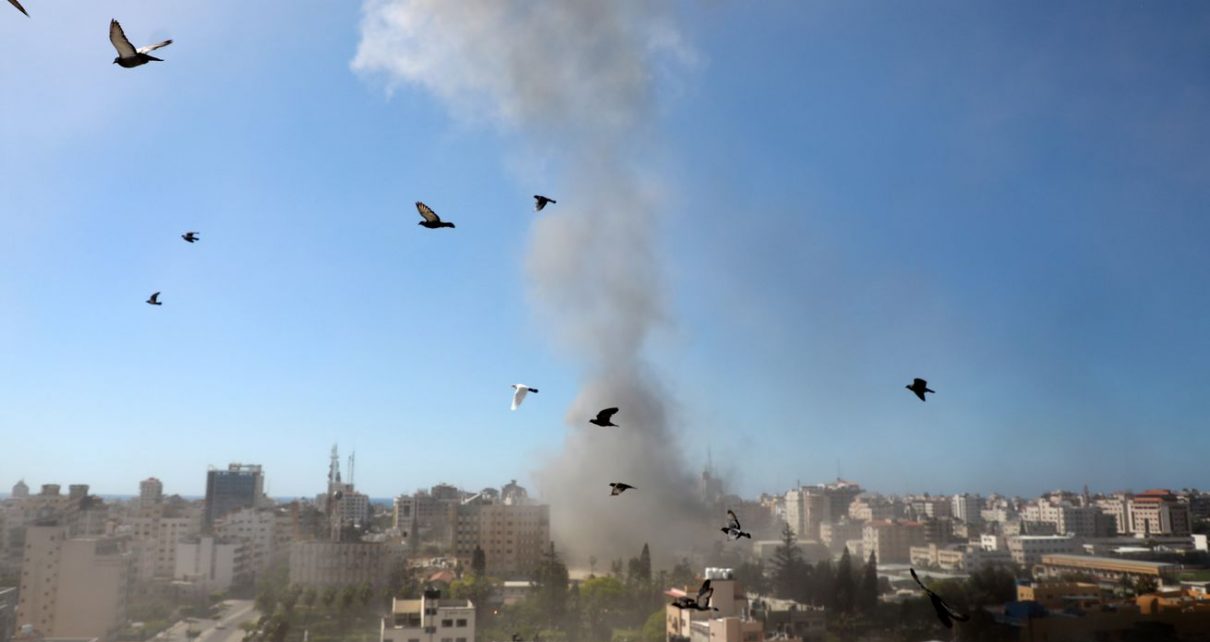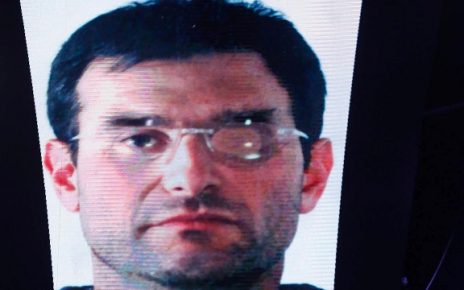
AP and Al Jazeera staff was forced to evacuate before Israeli airstrikes.
Israel’s military leveled a Gaza tower that housed offices for Al Jazeera and the Associated Press on Saturday as it continues to escalate its campaign against the Hamas militant group.
The 11-story al-Jalaa building, which also included residential housing, collapsed after being hit by an Israeli air strike, which the Israel Defense Forces said in a tweet Saturday was intended to target “Hamas military intelligence assets” allegedly based in the tower.
Israeli air strikes just destroyed the building housing Al Jazeera’s bureau, other media offices and people’s homes in Gaza #gaza #IsraelPalestine @AJENews @AJEnglish pic.twitter.com/5erQekL187
— Kalvin Ng (@kalvin_ng) May 15, 2021
The building’s destruction was covered live by Al Jazeera, and the AP said in a statement Saturday morning that it was “shocked and horrified” by the attack.
“We narrowly avoided a terrible loss of life. A dozen AP journalists and freelancers were inside the building and thankfully we were able to evacuate them in time,” AP president and CEO Gary Pruitt said. “The world will know less about what is happening in Gaza because of what happened today.”
According to the AP, the IDF warned AP journalists and other residents of the building of the incoming attack roughly an hour before three Israeli missiles struck the tower, and no casualties from the attack have been reported.
In a Saturday press conference, IDF spokesperson Lt. Col. Jonathan Conricus rejected labeling the al-Jalaa tower as a “media tower.”
“It’s not a media center,” he said. “It is a tower that was used by Hamas for three main purposes … but out of consideration for the safety of civilians, noncombatants, of course journalists, enough time was given for these people to evacuate the building.”
Conricus did not provide proof to back the IDF’s claims about Hamas activity in the tower, however, citing “source security.”
In a tweet after the strike on Saturday, White House press secretary Jen Psaki said that the Biden administration had “communicated directly to the Israelis that ensuring the safety and security of journalists and independent media is a paramount responsibility.”
Al Jazeera journalists also condemned the bureau’s destruction, and Al Jazeera acting director general Mostefa Souag described the attack as a “blatant violation of human rights” and a “war crime.”
“Whenever you see journalists doing live updates from Gaza, they’re usually standing on the roof of that building,” Al Jazeera English anchor Halla Mohieddeen said as the building was destroyed on air. “So that is a landmark, an institution that has now been razed to the ground in Gaza.”
Media buildings aren’t a new target for the IDF
The Saturday strike that destroyed Al Jazeera and AP bureau offices in Gaza isn’t the first time Israel’s military has targeted media buildings in the region. On Wednesday, the IDF destroyed what Washington Post Beirut bureau chief Liz Sly described on Twitter as “the main Gaza media building,” and the IDF has also made similar strikes in years past.
According to the Committee to Protect Journalists, a pair of towers destroyed by the IDF on Tuesday and Wednesday “house[d] more than a dozen international and local media outlets.”
They just took down the rest of the media building in Gaza pic.twitter.com/8pvJOxUSML
— Liz Sly (@LizSly) May 12, 2021
In an article Thursday, Ignacio Miguel Delgado, a CPJ representative for the Middle East and North Africa, condemned the strikes as “utterly unacceptable … especially since Israeli authorities know where those media outlets are housed.”
In 2019, the Gaza offices of the Anadolu Agency, a Turkish state media outlet, were destroyed by Israel’s military, and in 2012, two other media buildings, housing British, German, and Saudi news outlets, were hit with “pinpoint strikes,” according to Reuters.
As with Saturday’s strike, however, the IDF says those buildings were targeted because of a Hamas presence, and civilians were given a chance to evacuate.
“The building contained civilian media offices, which Hamas hides behind and deliberately uses as human shields,” the official IDF Twitter account said Saturday of the destruction of al-Jalaa Tower.
“[Gaza] is an extremely difficult battlespace where Hamas, by their strategy, by design, do everything in order to embed their own military infrastructure within the civilian infrastructure,” Conricus told reporters. “Everything is mixed. There is no one clear military target.”
After providing advance warning to civilians & time to evacuate, IDF fighter jets struck a multi-story building containing Hamas military intelligence assets.
The building contained civilian media offices, which Hamas hides behind and deliberately uses as human shields. pic.twitter.com/zeDjEquePD
— Israel Defense Forces (@IDF) May 15, 2021
In a statement Saturday, Senate Foreign Relations Committee chair Bob Menendez (D-NJ) said that he was “deeply troubled” by the IDF strikes on media buildings.
“I also believe there must be a full accounting of actions that have led to civilian deaths and destruction of media outlets,” he said.
IDF airstrikes in Gaza are intensifying
The airstrike that destroyed al-Jalaa Tower was just one of many targeting Gaza on Friday and Saturday as part of an IDF offensive against Hamas. Overnight, a barrage of Israeli airstrikes unleashed some 450 missiles — as well as artillery and tank shells from Israeli ground forces at the Gaza border — on a Hamas tunnel network in Gaza.
The airstrikes follow a deadly week of escalating clashes after tensions in Jerusalem boiled over on Monday with an Israeli police raid on the al-Aqsa Mosque and retaliatory rocket attacks by Hamas.
In addition to the conflict between Israel and Hamas, Israel has also been wracked with unusual, internal violence between mobs of Jewish and Arab extremists, as Vox’s Zack Beauchamp explained on Saturday.
According to the IDF, the overnight airstrikes in Gaza “caused many kilometers of the [tunnel] infrastructure to collapse” and was “a psychological blow to Hamas and their leadership.”
However, there are questions about how the IDF may have attempted to manipulate international media as the attack on Gaza was beginning Friday.
Initially, many international news outlets, including the New York Times, reported that the IDF had launched a ground assault on Gaza after the IDF Twitter account tweeted that “IDF air and ground troops are currently attacking in the Gaza Strip.”
An IDF incursion into Gaza would have marked a major escalation in the conflict. However, no such incursion occurred — and new reporting on Saturday suggests that the IDF may have deliberately misled media outlets in order to lure Hamas militants into a vulnerable position so they could be targeted by airstrikes.
According to the New York Times, Israeli media described the mistaken reports in international news outlets as part of a “planned ploy” by the IDF, with one headline declaring that “this is how the tunnels became death traps for terrorists in Gaza.”
Conricus, the IDF spokesperson, denied misleading international media at a press conference on Saturday, and described the confusion as an “honest mistake.”
“We hold our relations with international media very dearly,” Conricus said. “We work hard to keep them as such … unfortunately, mistakes happen.”
Palestinian casualties have also continued to mount as IDF airstrikes in Gaza intensify. At least 10 people, including eight children, were killed by Israeli missiles in a Gaza refugee camp overnight, and more were wounded.
According to Al Jazeera, the IDF said its forces are “not targeting civilians, but that fighters of Hamas, the group governing the Gaza Strip, have been hiding among them.”
However, a spokesperson for the United Nations Relief and Works Agency, or UNRWA, rejected that explanation Friday.
“This is total disinformation, that Hamas [is] hiding in UN camps and that being the reason for striking … extremely densely populated refugee camps,” UNRWA strategic communications director Tamara Alrifai told Al Jazeera.
As of midday Saturday, according to the AP, at least 145 people have been killed in Gaza, including 41 children. According to the IDF’s Conricus, 10 civilians, as well as one IDF soldier, have been killed in Israel.





